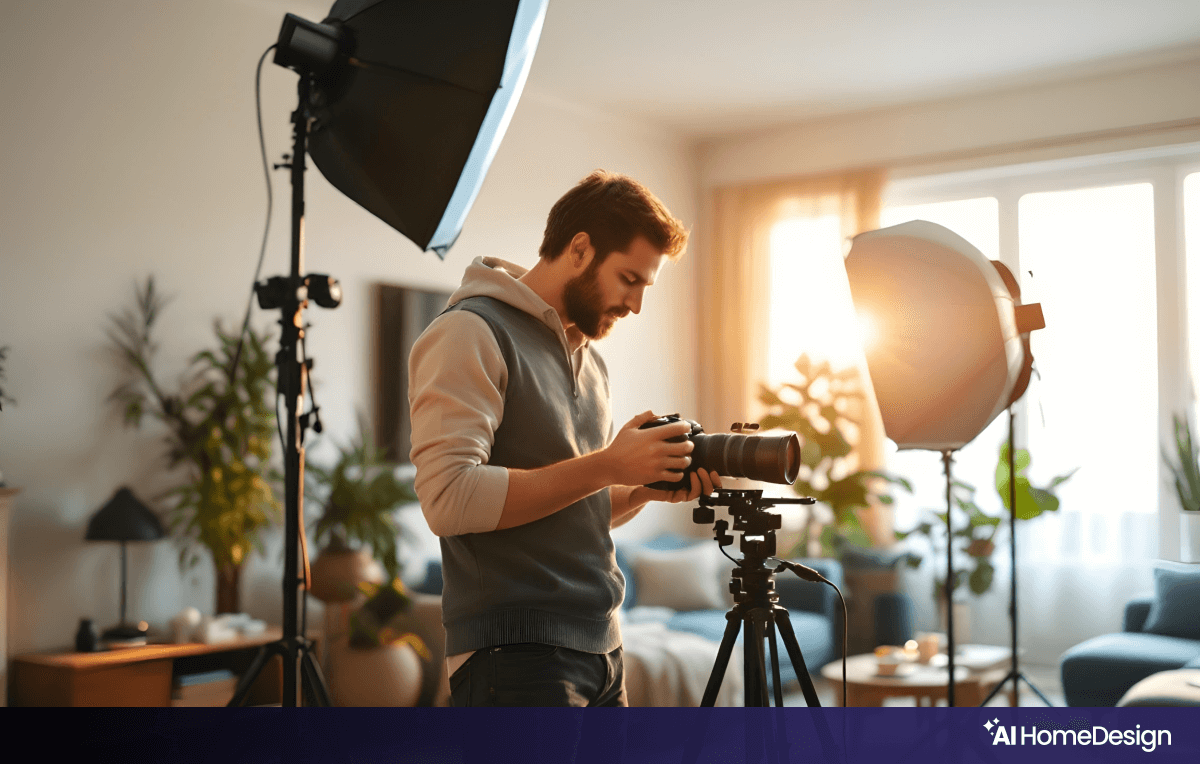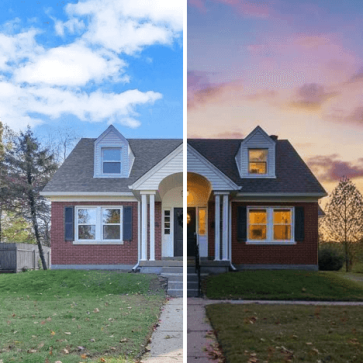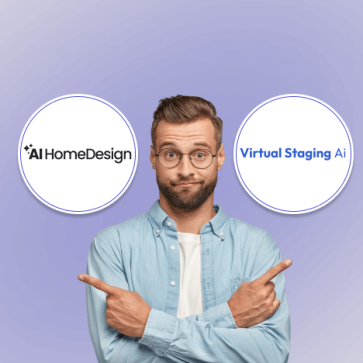In the world of real estate marketing, high-quality photography is crucial for successful virtual staging. It can create appealing visuals that attract potential buyers and enable sellers and agents to present properties in the best possible light.
In other words, the photographs are the only mediatory for digital staging, and they play a key role in the success of digital staging. That is why the quality of photos can make a big difference in higher sales and faster offers.
In this article, we will explore how to shoot a property for virtual staging including preparation, equipment, and techniques.
Preparing a Property for Shooting
The first and most important step to shoot a property for virtual staging concerns preparation, ensuring your photos look professional and inviting. That is why we list the main steps to prepare the property to consider:
A. Decluttering and cleaning
For sure, the process of preparing a room for shooting will involve some degree of decluttering and cleaning. Even if you miss some cluttering items when preparing the room for shooting, nothing to worry about! As a part of our photo editing services, we at AI HomeDesign can remove items professionally from the photo using AI, improving the cleanliness of the space by:
Emptying the whole room: We automatically empty your whole room of any clutters in seconds!
Masking items one by one: We brush on specific objects to mask them and remove those objects from your picture

When preparing the rooms to take photos for virtual staging, keep in mind to:
- Remove personal items: Start by decluttering the space by removing items such as your family photos and other distractions. You need to create a neutral environment for the potential buyers to envision themselves in the space.
- Clean surfaces deeply: Clean and wipe down surfaces, vacuum carpets, and mop floors, especially for the most viewed spaces such as kitchens and bathrooms. Remember that a clean space can enhance the overall appeal and make the virtual staging process more effective.
B. Ensuring good lighting
- Natural light vs. artificial light: To effectively shoot a property for virtual staging, natural light is preferred since it can provide the most flattering environment. For the most effective result, open the curtains and blinds to let in as much light as possible. Use artificial light to brighten dark areas only in case natural light is insufficient.
- Time of day for optimal lighting: Professional photographers always shoot at the most suitable time, popularly referred to as the Golden Hour. That’s early in the morning or late afternoon when the sunlight is softer. If you lose the chance to shoot in the morning, enjoy your midday light, let the shadows disappear, and then try shooting again.
C. Setting up the space
Though cleaning and being spotless is the key, always consider space settings, which include everything from furniture arrangement to the corner or angle you use for shooting a property for virtual staging.
- Arranging furniture: Arrange the furniture to highlight the room’s functionality. If the property is vacant, virtual staging will complement the space in styles tailored to the market’s taste.
- Considering space and flow: Ensure that the pathways are clear. Take a second look at pathway connections before shooting a property for virtual staging, ensuring potential buyers can effortlessly visualize moving through the space.
Looking More Professional
Having the right equipment can make a significant difference in the quality of your photos. Here’s what you need:

A. Camera options
- DSLR or mirrorless cameras: Investing in a good-quality camera such as a DSLR or mirrorless camera offers better image quality and versatility. It makes a difference compared to standard point-and-shoot cameras.
- Smartphone cameras: Many modern smartphones have excellent cameras. These kinds of cameras can produce high-quality images through proper lighting and composition. So, if you’re not looking to own a professional camera for real estate photos, opt for a flagship smartphone with a more-than-decent camera!
B. Tripod for stability
A tripod can help you achieve sharp images by eliminating camera shake, especially in low-light situations. A good tripod also gives you the chance to maintain consistent framing across multiple shots.
C. Lenses
One of the main features that directly impact the quality of your images is to use the right lens. That is why we highlight the kinds of lens options you need to have in your pocket! Though you may require advice from professional photographers on this, here is a brief on the different lenses you need for taking photos for virtual staging.
- Wide-angle lens: A wide-angle lens, typically a 16-35mm usually used for full-frame cameras, can be an ideal option to shoot a property for virtual staging. Allowing you to capture more of the room in a single shot, this lens helps to make spaces appear larger and more inviting.
- Additional lenses: It is advised to have a prime lens for close-ups or details and a zoom lens for flexibility in framing your shots depending on the property.
D. Lighting equipment
Though natural light is one of the main components of property shooting, additional lighting is sometimes required. That is why you need to consider using:
- Flashes: Using flashes, you can illuminate darker corners of a room or have a balanced natural light.
- Reflectors: They can be helpful in shadowy areas by bouncing light and enhancing the overall brightness of your images.
Shooting Techniques: Getting Down to the Actual Business
Once the property is prepared and equipped, you need to apply some basic steps to shoot a property for virtual staging. Here are some effective methods:
A. Composition tips
- Rule of thirds: To set the camera at the right focal point, divide your image into thirds both horizontally and vertically. This way, you can place the points of interest along these lines or at their intersections, making the final photo more balanced and engaging.
- Angles to capture: A wide shot will be in your favor and give you a chance to showcase the entire room. Use close-ups to catch details.
B. Taking multiple shots
When it comes to shooting a property for virtual staging, always take the safe approach and take multiple shots of any space and try these techniques:
- Trying different angles and heights: Sometimes, it is hard to find the most flattering spot in the first take. Instead, shoot from various heights—eye level, slightly lower, or slightly higher. This angle variation can enhance the room’s dynamicity and appeal.
- Capturing various rooms and features: Always take pictures of all key areas such as living rooms, bedrooms, kitchens, bathrooms, and outdoor areas. You can emphasize unique features like fireplaces, built-in shelving, or outdoor patios. Know that listings with too few or not enough images will leave the buyers wondering and lower your chances of making a sale!
C. Focus on key selling points
Depending on the market priority at the time of the property sale, you need to shoot a property for virtual staging by emphasizing its key features.
- Highlighting unique architecture: Focus on the distinctive architectural features of the building including crown molding, large windows, or unique layouts that set the property apart.
- Showcasing outdoor spaces: The exterior is as important as the interior. You need to capture gardens, patios, and balconies to enhance a property’s appeal. Don’t forget to use wide shots to show the area and close-ups for details.

Post-Process Editing: The Last Step of the Adventure
After capturing your images, you’re halfway there! Here, you have one more step to finalize your image for the property listings. Through post-process editing, you can enhance the image quality further. Here are some steps to follow:
A. Basic editing techniques
- Adjusting brightness and contrast: Leveraging our AI-generated tools, we at AI HomeDesign can help you adjust brightness and contrast and ensure the images are well-lit without losing detail in the highlights or shadows.
- Enhancing and adjusting photos: After uploading your high-quality photos to the platform, we enhance the images by adjusting exposure and color balance, making them visually more inviting and realistic.
B. Preparing images for virtual staging
- Renovating photos: We at AI HomeDesign use AI tools to make style, light, and color changes both for interior design and home renovation including restyling furniture, and changing the color of ceilings, walls, and floors.
- Considering file formats and resolution: We use high-resolution formats (like TIFF or PNG) for virtual staging. JPEGs can be fine for web use provided that they have been taken in high quality.
- Avoiding pictures taken with flash: We suggest using a camera with a high dynamic range (HDR) to capture details accurately. We use the ultimate quality of AI to edit property images with the highest resolutions and lighting depending on your individual and budget preferences.
- Using photos with better alignment: If you’re dealing with misalignment in your property photos, AI HomeDesign’s photo editing service corrects all horizontal or vertical lines and levels up the pictures with our AI editing services.
It’s Not Rocket Science. Just Stay on Track
Shooting a property for virtual staging requires careful preparation, the right equipment, effective shooting techniques, and post-editing requirements. By decluttering the space, observing lighting standards, and applying quality cameras and lenses, you can capture images for successful virtual staging.
Remember to shoot from different angles and focus on key selling points. With proper post-processing, your images will not only highlight the property’s features but also engage potential buyers.
By mastering these techniques, you can create stunning visuals to enhance your property listings, facilitating quicker sales in today’s competitive real estate market.
FAQs
Make sure the spaces are shot in landscape, not portrait. An image in landscape mode is wider than it is tall, showing a lot more area. This quality allows graphic designers to use the maximum amount of space to add virtual features. In addition, real estate marketing websites such as Zillow use landscape photos that look better on multiple listing services.





